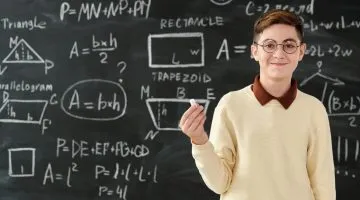ADHD And Math: How to Help Kids
reviewed by Camille Ira B. Mendoza
Updated on May 23, 2024
Does your child with ADHD dread math? This subject can be hard to understand, even for adults. So, it is no wonder that a student with a different style of thinking has a tough time, and it is natural to ask yourself, «Are kids with ADHD good at math?»
This article will provide useful tips from certified math experts specializing in working with ADHD kids. Implement them to boost your child’s performance and build a consistent and effective learning routine!
Why is math hard for ADHD kids?
Math can be hard for kids with ADHD because this disorder impacts working memory and the brain’s ability to hold and manipulate information. This can make it difficult to remember multiple steps in a math problem or juggle different formulas at once.
So, it’s not quite accurate to say that people with ADHD are bad at math. Neurodivergent people (those whose brains work differently) often need more time to understand the logic behind non-existent objects, as many ADHD brains work using the «Out of sight, out of mind» (or object permanence) concept. That’s why these kids may start having math problems even in elementary school.
However, learning how to use equations or math problems in real life will help the kid better understand math principles and stay focused. Create a step-by-step learning method to keep them focused on the key points.
Try to add some entertaining elements to the math lesson. There is a high chance that your child is tired of boring classes.
Book a demo lesson with one of our tutors.
Provide them with motivation and make things engaging. Math for kids with ADHD should be as fun and entertaining as possible. Traditional memorization methods can be boring for kids with ADHD who crave novelty and stimulation. This approach can lead to disengagement and difficulty learning new data.
“Children struggling with math could have a vision problem, making it physically difficult for them to understand and process the information. We need over a dozen visual skills to see and learn! ”
«If a child has an eye tracking problem, they might re-read the same number over and over or jump around on the page, leading to poor comprehension. Their eyes also might not be working together, leading to their brain suppressing an eye. There can even be deficits on a processing level, hindering a child’s ability to understand the spatial concepts that numbers and math concepts represent.
We have had several patients who didn’t like school or struggled with math, only to discover they had a vision problem no one had noticed. Children struggle to vocalize these issues because for them their vision is ‘normal’ as it is the only way they have ever seen.»
Does ADHD affect math skills?
Think about how you can incorporate a kid’s favorite subject into math
It may be hard to learn math with ADHD due to concentration and memorizing difficulties. People with ADHD are prone to make small mistakes, like forgetting symbols, whose placement is crucial even for elementary school students.
Here are some common math challenges:
- Difficulties concentrating on math problems. They can be too complicated for a student, so their brain decides to switch attention to something more familiar. It’s a natural response, so don’t blame your kid for it.
- Trouble remembering math facts and formulas. Particularly when they are complicated or when you need to use multiple similar formulas. Most time, it can be easy to mix them up.
- Making careless mistakes like «5+7=11» or «-29+19=10». The student may just forget that they need to place a sign there. It’s one of the most common ADHD math problems.
- Difficulty staying organized with math homework. It can be too hard to solve dozens of math problems in one sitting. Your child may do the one block of questions and suddenly get distracted by something else.
- Taking longer to complete math assignments. It may take a child more time than others to do a particular math task, and this can lead to frustration. It is recommended to set strict deadlines according to your child’s abilities.
It’s important not to associate neurodivergence with bad habits. It wouldn’t be right to say that students with ADHD struggle in math. They can still learn and understand even more math. You just need to find the personalized approach that suits your kid.
Can someone with ADHD be good at math?
Yes, since many people with ADHD are good mathematicians. If your kid is naturally interested in math and STEM subjects, they will show one of the best results in the class. However, if they don’t like hard sciences, your kid still can be good at math. It just takes more time.
Your kid is a creative genius. Please, remember about it
People with ADHD often excel at problem-solving. This can be a huge asset in math, with multiple varieties of ways to approach a problem. The most vivid example is the quadratic equation, which can be solved with a discriminant or by implementing Vieta’s formulas. Encourage the kid to use creativity in math. That way, you make it exciting and fun.
“According to Technium Science, audiovisual stimuli facilitate information processing and memorization, which makes smartphone applications an effective learning tool for children with ADHD. ”
Math is based on logic and repeating patterns. While some people with ADHD don’t like to follow them strictly, some kids request to use them in any daily activity. Math is full of repeating actions. Once your kid understands the formula, they tend to experiment with it.
Some kids may have a natural hyperfocus on STEM sciences. It can become an advantage for those who teach children with ADHD math. However, don’t go overboard with it; as the kid may lose their natural interest in hard sciences.
8 tips of how to learn math with ADHD
- Break the information into small chunks
- Set your focus on understanding, not memorizing
- Implement hands-on learning
- Use visual aids
- Implement short breaks and active movements into the kid’s learning routine
- Create a dedicated study space
- Reward the kid
- Use the help of a teacher who has experience working with neurodiverse kids
Break the information into small chunks
The smaller, the better. Switch to the next part of the task only after ensuring the kid understands the previous information. A traditional school-like 45-minute continuous teacher’s monologue won’t suit the needs of ADHD kids.
Set your focus on understanding, not memorizing
Math for ADHD students should be palpable. Once they understand the logic behind the task, they will easily solve similar problems. Ensure that they really understand the logical process behind the current task before switching to another one.
You won’t let an inexperienced driver who doesn’t know any road rules drive on a busy highway. First of all, you teach new road rules, the basics of how to drive a car and try some practice on a country road. The same approach applies to ADHD kids and math.
Implement hands-on learning
Use manipulatives like counters, blocks, or even pictures to represent concepts. It can make math more tangible and engaging. Writing and drawing help to solidify the knowledge.
Use visual aids
Remember the «out of sight, out of mind» concept. You should figure out how to make everyday objects like bottles of water, flowers, or pens simple yet effective visual aids. Implement this practice for kids to learn math with ADHD.
Implement short breaks and active movements into the kid’s learning routine
If you don’t do it, the kid will get distracted after 10-15 minutes. Allow the kid to spin or use the fidget spinner. Turn their activity trait to advantage. It will help a child with ADHD struggling with math.
Create a dedicated study space
Minimize distractions by having a clutter-free environment to ease math for ADHD students. Let your kid have their own table for studying.
Reward the kid
Celebrate their achievements, big or small! It will keep them motivated and engaged. Motivation releases dopamine and creates a positive link in a kid’s brain. That way, when they think about math, they will associate it with a great time with you and the rewards that you’ve given to them.
Use the help of a teacher
Ensure that a teacher has experience working with neurodiverse kids. Here, at Brighterly, dozens of tutors know how to teach math to kids with ADHD. You can book a demo lesson so we can provide you with personalized learning plan recommendations.
How to teach math to children with neurodivergence
- Be creative.
- Use mnemonics.
- Let your kid move.
- Incorporate easy games into every lesson.
- Add storytelling and link math concepts into stories.
- Visualize the learning process to make math easier to grasp.
We, at Brighterly, use proven yet creative approaches to teach children with ADHD math. We incorporate stories, physical activities, interactive elements, and other tricks to make STEM subjects easy to understand.
Math strategies for students with ADHD
The best math strategy for ADHD students is to aim for focused practice and test sessions rather than long, tedious ones. Instead of trying to study for 120 minutes continuously, split your 2-hour lesson into six 25-minute sprints with five 10-minute breaks.
ADHD affects a person’s ability to pay attention and control impulsive behaviors. So, if you don’t add some controlled movement, a kid may become overly active. Use small multisensory tools to control impulsivity by redirecting energy and stimulating the senses. These can be fidget toys, wobble cushions, chair bands, or any other object where kids can safely unleash their energy.
Dr. Ray Christner, doctor of psychology, NCSP (nationally certified school psychologist), ABPP (American Board of Professional Psychology):
“Incorporate interactive and hands-on learning activities. Children with ADHD often benefit from interactive and hands-on learning experiences. ”
«Lu et al. (2020) studied using an abacus within general education settings. The results showed that no children in the classes using an abacus course were diagnosed with developmental dyscalculia (a specific mathematical learning disability), whereas approximately 6% of students in the control class (not using the abacus course) received a diagnosis. This research found that those taught with an abacus demonstrated a positive difference in mathematics computation skills and spatial short-term memory.»
Ask a kid to visualize the task. Math for kids with ADHD should be as tangible as possible. Use numbers, sketches, and even the child’s favorite computer and offline games to visualize the problem’s conditions and logic for solving it. Use the color to boost the kid’s focus.
Students with ADHD often don’t notice when the operations sign changes from plus to minus. Before beginning work on math problems, ask students to highlight key math operations. Color addition signs green, multiplication can be signs pink, negative numbers can be orange, and so on.
“Children with ADHD may experience auditory and visual processing problems that affect their ability to effectively concentrate, focus, and remember, leading to difficulties in learning math specifically. ”
Children with ADHD often benefit from multisensory teaching methods that engage more than one sense at a time. For math, this means not just telling them how to do something (auditory) but also showing them (visual) and letting them physically manipulate objects (kinesthetic).
Many people with ADHD can zone out when they see a long string of text. By visualizing text into tangible pictures, they can better understand this task. It will take more time to solve it, but that way, you have a higher chance that the kid actually solves it on their own.
Build a positive attitude with open communication and clear and concise instructions. As we said earlier, don’t forget to celebrate even small achievements.
Conclusion
Remember that kids with ADHD can learn to solve math problems. They can be great at STEM activities, though just need more time. The key to success is to deliver a personalized approach that suits a child’s needs.
Brighterly has dozens of tutors who specialize in working with neurodivergent kids. They will develop a personalized math study plan and easily modify it during training to ensure that your kid understands every single math topic.
Book the first free lesson with our tutors today to boost your kid’s math skills!

















